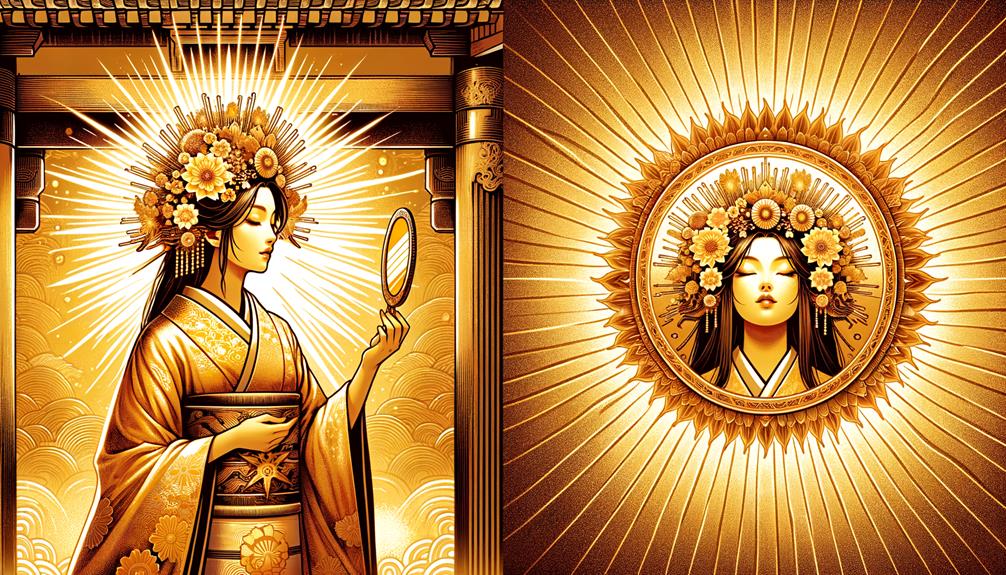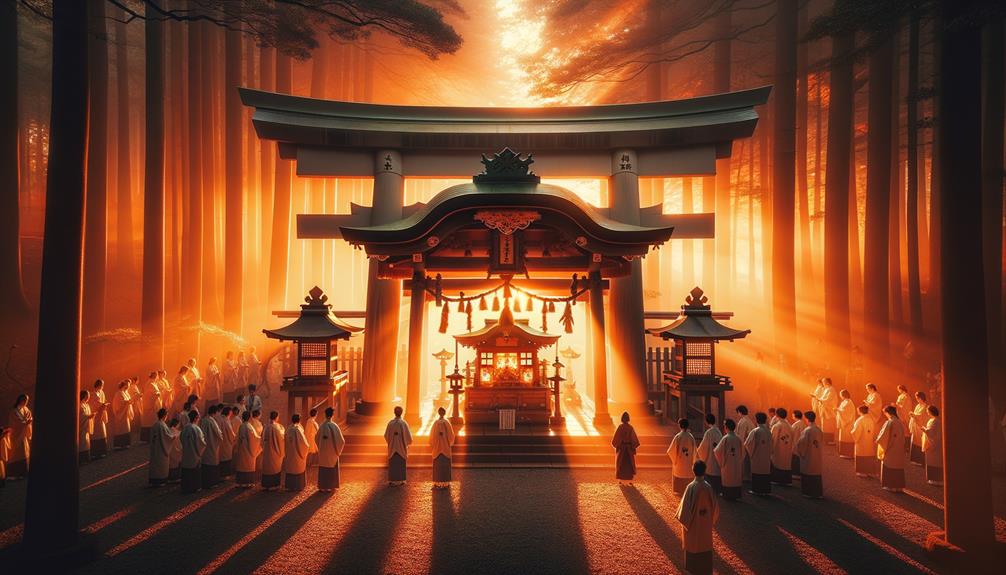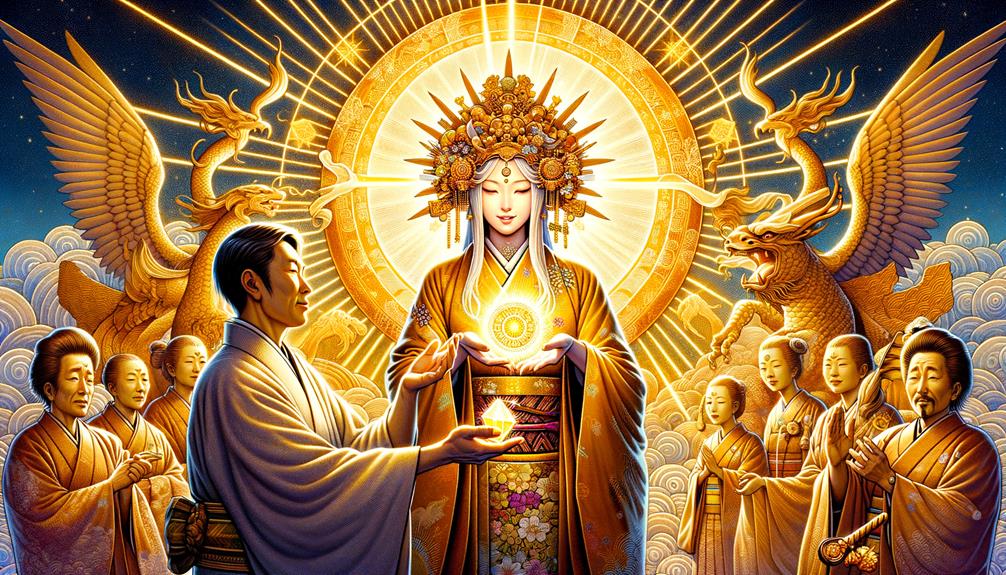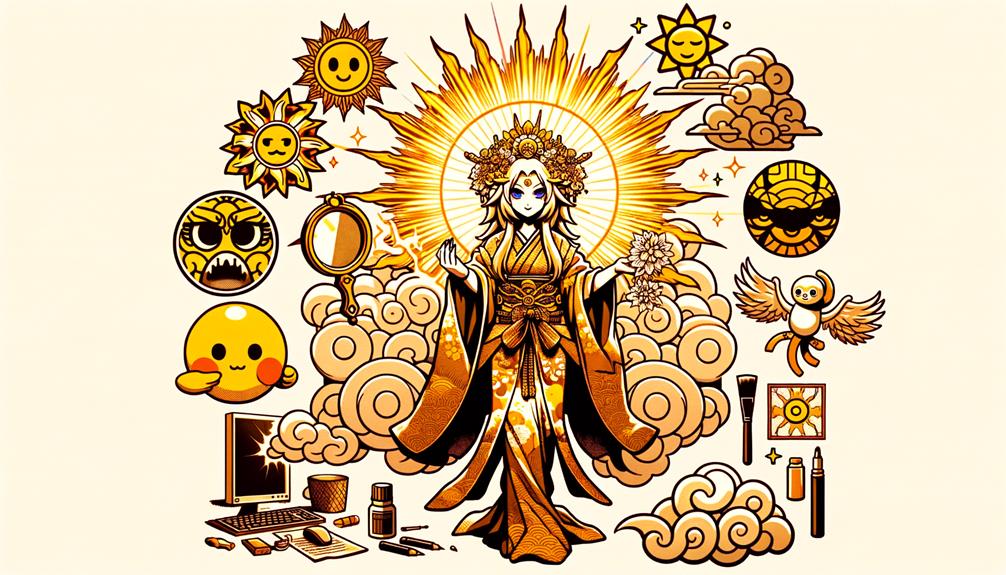'You know how people say 'the sun is the heart of the world'? Well, in Shinto mythology, that heart is embodied by none other than Amaterasu, the Sun Goddess. Much of my research has been focused on this extraordinary deity, studying her beginnings, her critical role in Shinto mythology, how she is revered, and her rituals. Also, her continuing influence on the Japanese imperial lineage is quite intriguing. It's pretty remarkable to see Amaterasu, a female figure, shining brightly in a sphere often dominated by males in other cultures. She truly highlights the richness of Japan's spiritual and cultural traditions. But her reach isn't confined to the past; you can still feel her impact in today's pop culture. So, what makes this heavenly deity so compelling and influential? Let's dive in and uncover the secrets behind Amaterasu and shed more light on her divine persona.'
Understanding Amaterasu's Origins

Let's chat about the compelling beginnings of Amaterasu, an essential figure in Shinto mythology. She came into existence when Izanagi, a key god in Shinto beliefs, cleansed his left eye. As the Sun Goddess, Amaterasu holds a prestigious position in Japanese folklore as a divine light source, embodying the sun itself.
Izanagi's purification ritual, which he underwent after his journey to the underworld, resulted in the birth of this bright Shinto goddess. This story is preserved in ancient Japanese writings. Together with her brothers, Tsukuyomi, the moon god, and Susanoo, the storm god, Amaterasu holds a prominent place as one of the Three Precious Children.
For the Japanese, Amaterasu is more than just a deity. She is a connection to their royal lineage. The Imperial House of Japan holds the belief that they are direct descendants of this divine sun goddess, which adds reverence to her standing. However, there are different legends about the birth of Amaterasu and her siblings, indicating a rich tapestry of tales in the Shinto tradition.
Getting to know Amaterasu more, we can see her significant roles in Japanese culture. She is a sun deity, a figure of ancestry, and a representation of the country's divine heritage.
Amaterasu's Role in Shinto Mythology

Let's chat about Amaterasu, a key figure in Shinto mythology. Amaterasu's role is quite big, with her ruling over the heavenly domain of Takamagahara. She's the embodiment of order and purity and is seen as the ancestor of the Imperial House of Japan. As Amaterasu, she's like a shining light, loved for her caring nature and seen as a symbol of the steady passage of time.
Amaterasu was born from the divine parents Izanagi and Izanami, who are the creator deities of the Shinto religion. This makes her role in the Shinto mythology deeply embedded. There's a story of her hiding away in the Heavenly Rock Cave, bringing darkness to the world. This is seen as a symbol of chaos and disorder. The other deities had to persuade her to come out, bringing back balance and light to the world.
Here's a quick summary:
- Amaterasu rules over the heavenly domain of Takamagahara.
- She embodies order, purity, and light in the Shinto faith.
- Amaterasu is seen as the ancestor of the Imperial House of Japan.
- The story of her hiding and returning from the Heavenly Rock Cave shows the importance of balance and order.
- The effort made by other deities to bring her back highlights the importance of community unity and collaboration.
Amaterasu's role isn't just confined to the heavens. It's intertwined with the cultural and historical fabric of Japan.
Worship and Rituals of Amaterasu

Delving into the realm of Amaterasu's influence in Japan's celestial and historical narrative, one can't help but be intrigued by the worship and rituals associated with her. Key to these practices is the Ise Grand Shrine, a highly respected Shinto site. This is where people believe Amaterasu Omikami resides on Earth. The shrine is where ancient beliefs are kept alive, highlighting her as the divine ancestor of the Imperial family, the Queen of Heaven, and the cosmic spirit.
Shinto traditions pay respect to Amaterasu as the kami that brings order, purity and nourishment to all living beings. Throughout Japan, there are many shrines that pay tribute to her, reflecting her lasting importance. The Grand Shrine of Ise is particularly noteworthy as it protects the Imperial Regalia, a symbol of her lineage. These sacred objects, such as the Eight-Span Mirror, the Grand Jewel, and the Grass-Cutting Sword, are key to the rituals conducted in her honor.
The worship of Amaterasu reflects the structured Japanese society, symbolizing the dynamic balance between tradition and progress. Therefore, getting a grasp on Amaterasu's worship helps us unravel the complex fabric of Japan's deep-rooted spiritual heritage.
Amaterasu's Influence on Japanese Imperial Lineage

Without a doubt, the mythology of Amaterasu has had a deep impact on the Imperial House of Japan's lineage, solidifying her sway in both spiritual and historical aspects. It's interesting to note that the Japanese Imperial Family asserts their lineage from Amaterasu. This claim not only fortifies their right to govern as a divine prerogative but also reinforces Amaterasu as the forbearer of the Japanese people.
Their lineage, traced back to Amaterasu, is further validated through the Imperial Regalia, three sacred items believed to be gifts from Amaterasu. These items symbolize legitimate authority and divine approval, and they include:
- The Eight-Span Mirror
- The Grand Jewel
- The Grass-Cutting Sword
Here's something fascinating: according to legend, Amaterasu sent her grandson, Ninigi-no-Mikoto, to bring peace to Japan. He later became the progenitor of the First Emperor, Jimmu. This tale interweaves the Imperial family members with the goddess, bolstering their sacred assertions. The Ise Grand Shrine, dedicated to Amaterasu, stands as a symbol of her lasting importance. It not only houses the regalia but also acts as a spiritual hub for the Imperial family.
Amaterasu's Representation in Pop Culture

If you take a look at pop culture today, you can't miss the impact of Amaterasu, the mythological Shinto sun goddess. From video games to anime, her stories have made a lasting impression and hold a key spot in various forms of media. These stories, deeply embedded in the Chronicles of Japan, have been reimagined to fit into the daily life of modern Japanese society.
| Medium | Amaterasu's Representation | Impact |
|---|---|---|
| Video Games | Main character in 'Ōkami', summon in 'Final Fantasy' | Increased player engagement |
| Anime & Manga | Respected deity | Boosted storyline intricacy |
| Art, Music, Fashion | Emblem of beauty, light, divinity | Shaped style choices |
In Miyazaki Prefecture, people pay their respects to her at a recently established shrine, showing that the respect for the Shinto sun goddess is still alive and well. This portrayal in pop culture not only breathes new life into age-old tales but also introduces them to people all over the world. Amaterasu is often shown with a variety of gods and three goddesses, adding more layers to her story. As a result, the Shinto sun goddess, Amaterasu, goes beyond ancient texts and becomes a significant part of Japan's cultural identity and its influence around the world.
Frequently Asked Questions
What Did the Sun Goddess Amaterasu Do?
Amaterasu, the sun goddess of Shinto faith, plays a vital role in sustaining and balancing the world's nature. She's best known for her act of withdrawing herself, which plunged the world into darkness. The story goes, she only returned after being tricked by a smart plan involving a mirror and dance routine.
What Is the Story of the Sun Goddess Amaterasu Disappearing Into the Cave?
You know that story about Amaterasu, the sun goddess? She went and hid herself in a cave one day, and just like that, the whole world was dark. But you'll never guess what got her to come out. It wasn't a superhero or a prince, but just a rooster crowing. Oh, and a mirror, some jewels, and a whole bunch of gods having a good laugh. Once she was out of the cave, the world was bright again, and everything was back in its place.
What Is the Myth Amaterasu and the Cave About?
Have you ever wondered about the story behind the myth of Amaterasu and the Cave? Well, let me tell you, it's a tale that will have you on the edge of your seat. It's all about Amaterasu, who is no ordinary goddess – she's the goddess of the sun. One day, she decides to take refuge in a cave, plunging the world into darkness. But fear not, a rooster, a mirror, and a jewel manage to coax her out of her hiding place. So, what's the big deal, you ask? Well, this story is more than just a tale. It's a powerful symbol of the re-emergence of light and hope.
Did Amaterasu Marry Her Brother?
Well, the answer to whether Amaterasu, known widely as the Sun Goddess in Shinto mythology, tied the knot with her brother is a bit uncertain. There's really no solid reference in the myths to back up such a claim. The tales primarily place her as a revered deity and don't really delve into her personal relationships. So, the focus isn't so much on her love life, but rather on her status and the power she holds.

